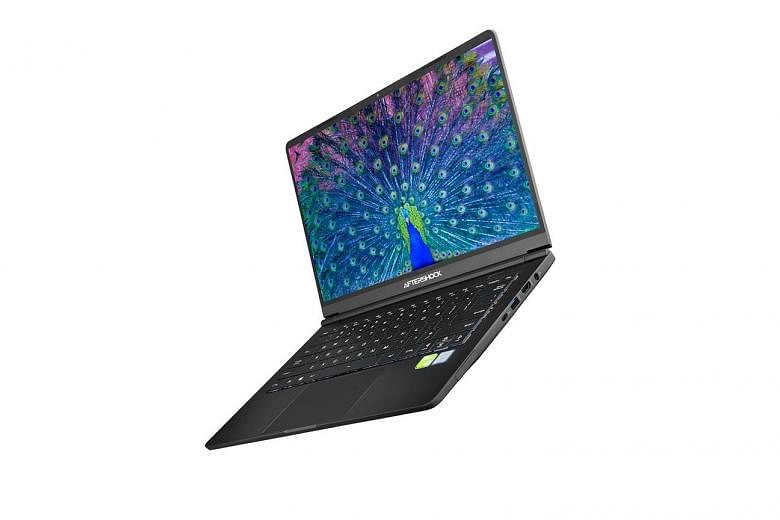Aftershock's latest notebook is, against expectations, not designed for gaming.
Instead, the local PC builder, which forged its reputation with build-to-order gaming computers, has launched a sleek mainstream notebook named Lunar 14.
It is not Aftershock's first stab at an ultrabook, as these laptops are usually dubbed.
Previous tries include the Halo and the Helix, though both were flawed in their own ways. Aftershock's existing P-14 ultrabook improves on them, but it is starting to look long in the tooth.
On the other hand, the Lunar 14 looks modern with nods to current trends such as slim display bezels and a lightweight magnesium-alloy chassis. The latter is what makes it one of the most portable ultrabooks in the market, at around 1.05kg.
My review set is a nondescript dark-grey slab that feels solid. Its lid has a little give in the middle - not as sturdy as some laptops I have tested - but still acceptable.

-
FOR
• Thin and lightweight
• Nondescript look appropriate for offices
• Good selection of ports
-
AGAINST
• Keyboard feels cramped
• Lack of biometric authentication
-
SPECS
PRICE: $1,450
PROCESSOR: Intel Core i7-8565U (1.8GHz)
GRAPHICS: Nvidia GeForce MX250
RAM: 8GB DDR4
SCREEN SIZE: 14 inches, 1,920 x 1,080 pixels
CONNECTIVITY: USB Type-C 3.1 Gen 1, 2 x USB 3.0, 1 x USB 2.0, HDMI, Ethernet port, headphone jack
BATTERY: 47 watt-hour
-
RATING
FEATURES: 4/5
DESIGN: 4/5
PERFORMANCE: 4/5
VALUE FOR MONEY: 4.5/5
BATTERY LIFE: 5/5
OVERALL: 4/5
The Lunar also comes with Nvidia's latest entry-level MX250 graphics chip that is more capable than the middling integrated graphics chip in most ultrabooks.
Now, this Nvidia graphics chip does not turn the Lunar into a gaming notebook, but it allows the laptop to run less graphically intensive games, such as popular e-sports titles, at a decent clip.
It ran the first-person shooting game Apex Legends at a respectable 40 to 50 frames per second at the the laptop's native 1,920 x 1,080-pixel screen resolution. While I had to tone down some graphics settings to ensure the game ran smoothly, what probably helped was that the Lunar's MX250 chip is a 25W variant that runs at a higher speed than the base 10W version.
The laptop's 14-inch display offers a wide viewing angle, though it is more reflective than what I had expected given its matt finish. The screen brightness is on the low side - I have to set the brightness at 75 per cent and higher to use it comfortably in a well-lit office.
But there is no biometric security. Aftershock plans to add an optional facial recognition camera to the model.
I would have preferred more spacing between the keys on Lunar's backlit keyboard. The Up and Down arrow keys, as well as the Function ones, are also small.
But the touchpad is large and supports Window 10's multi-finger gestures.
To my surprise, there is a pull-down Ethernet port, which rarely makes an appearance in slim ultrabooks. The Lunar also has an HDMI port and a full-size USB port, unlike newer ultrabooks that have only USB-C ports. The Aftershock laptop does have a single USB-C port, though it is not a faster Thunderbolt 3 port.
Like Aftershock's other products, the Lunar is priced competitively.
My review set, which has an Intel Core i7 chip with 8GB of system memory and a 512GB solid-state drive, costs $1,450.
This is cheaper than the Acer Swift 3 ultrabook, which is one of the more affordable models in the market with similar hardware. The Acer - at 1.5kg - is heavier too.
The Lunar lasted seven hours and 18 minutes in the video-loop battery test with the screen brightness set to maximum. This is on a par with most ultrabooks equipped with the latest Intel processor.
Overall, the Lunar ticks all the boxes for an ultrabook. It also surprised me with its capable graphics performance and by having a variety of connectors.


